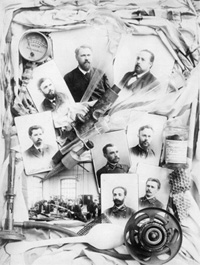
V.O. Hemilian was born on 27 August 1851 in the family of a college counsellor. In 1872, he completed a full course of study at the chemical department of the St Petersburg Practical Technological Institute and was awarded the rank of first class. After graduation, Valery Alexandrovich worked as a laboratory assistant at the same institute for a year.
In 1872, his first scientific paper “Investigation of a new method of distillation with sulphuric acid” was published in the Russian Chemical Society journal together with N. Melnikov.
In 1873, V.O. Hemilian was sent on a year-long research trip to the Universities of Würzburg and Strasbourg, where his supervisors were Professors Wieslicenus and Goster. In the same year, he defended his dissertation on sulphonic acid derivatives at the University of Göttingen and was awarded the degree of Doctor of Philosophy.
After returning from abroad, V.O. Hemilian worked as a staff laboratory assistant at the institute for 1.5 years. Here he began his famous research on the synthesis of triphenylmethane, its analogues and homologues.
In 1876, at a meeting of the Russian Chemical Society, V.O. Hemilian, on his own behalf and on behalf of D.I. Mendeleev and I. Bogusky, reported on the results of experiments on the compressibility of gases at low pressures. These experiments concluded that when the pressure was changed from 2200 to 20 mmHg, both positive and negative deviations from the Boyle-Mariotte law existed for air, carbon dioxide and sulphuric acid, while only positive deviations existed for hydrogen at these pressures.
In 1876, Valery Aleksandrovich accompanied D.I. Mendeleev on a business trip to North America, where they studied the organisation of oil production, oil extraction and distillation.

During 1877-1886, V.O. Hemilian worked as an associate professor of technical chemistry at the University of Warsaw, where he taught technical chemistry, general inorganic and special organic chemistry courses, and continued his research.
In September 1886, Valerii Oleksandrovych moved back to St. Petersburg University, where he defended his master’s thesis on 10 November. Later, his life and work were associated with the Kharkiv Practical Institute of Technology, where he worked as an associate professor from 1 August 1887 and as a professor of chemical technology from 12 July 1889. In 1888, Professor Hemilian visited glass and porcelain factories, chemical plants for the production of sulfuric acid, salts, soda and dyes in Germany and Austria; he got acquainted with the laboratories of universities in Prague, Vienna, Berlin and Munich.
At the institute, Professor Hemilian teaches students a course on mineral technology, water and fuel technology, manages the technical laboratory and project preparation. He provides lectures on raw materials for the chemical industry, the technology of acids and salts, and the technology of ceramic products at a high scientific level and on a broad practical basis. Using his textbooks, students studied the technology of minerals until almost 1922.
Professor V.L. Kyrpychov, Director of the Kharkiv Institute of Technology (the name of the university since 1898), wrote about the work of V.A. Hemilian: “V.A. Hemilian fully justified the expectations placed on him… He showed a thorough knowledge of the subject, which, due to his brilliant presentation, immediately put this subject forward and encouraged students to study it with special love and diligence… He brought the projects on technology to an excellent state.”
During his tenure at the institute, V.O. Hemilian wrote and published lectures: “Water and Fuel”, “Technology of Mineral Substances”, “Paper Production”, “Coloured Pigments”. It set up pilot plants for distilling, sugar production, a paint shop, a gas plant, and a ceramic materials plant.
In 1904, Professor Hemilian retired for health reasons. During his almost 20 years of work at the Institute, Valeriy Oleksandrovych trained many engineers and created a first-class laboratory for mineral technology for teaching students and conducting research. His last scientific work “On the composition and properties of the healing resources of the Crimean estuaries” was published in 1909, and he published more than 40 scientific papers in total. V.O. Hemilian died on 11 January 1914.
Professor V.O. Hemilian received constant help and support from his teacher, the outstanding scientist D.I. Mendeleev, for which he was elected an honorary member of the Academic Council of the Kharkiv Institute of Technology in early 1904 on the occasion of the 70th anniversary of the birth of the outstanding chemist.
